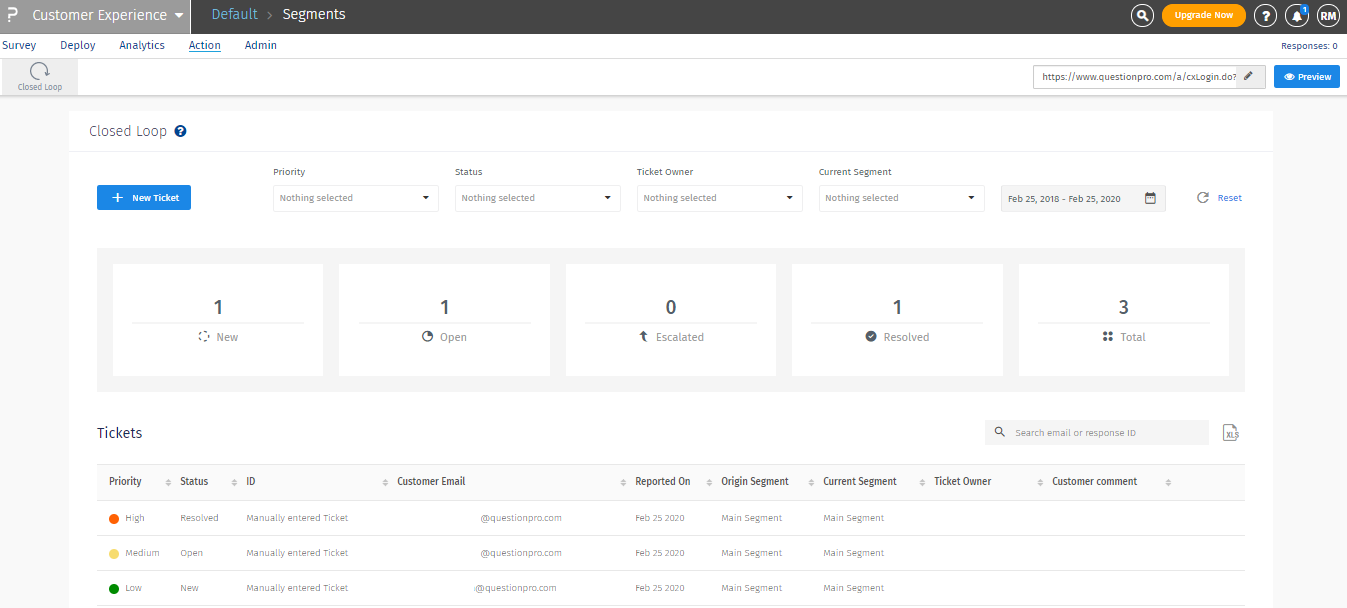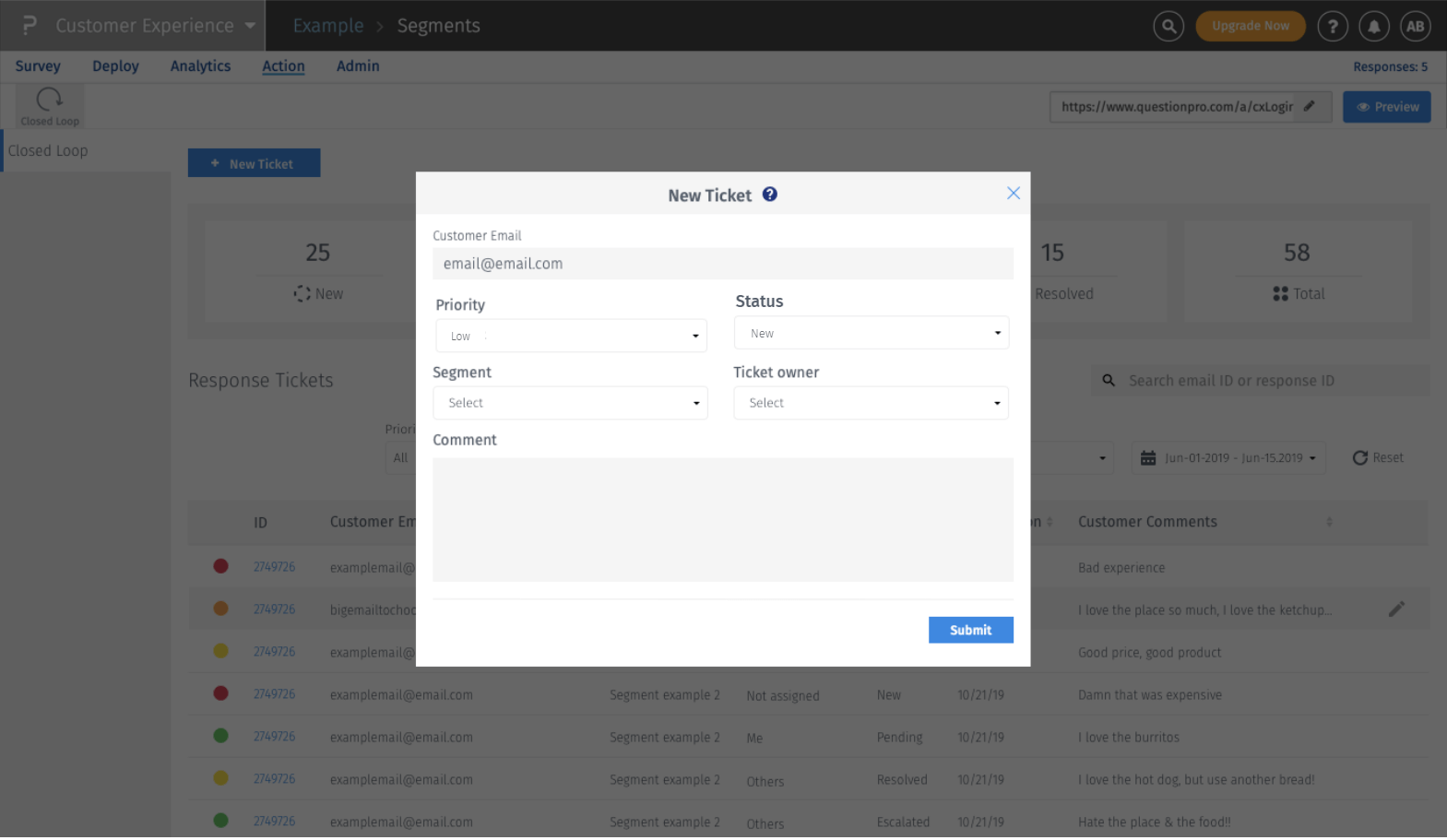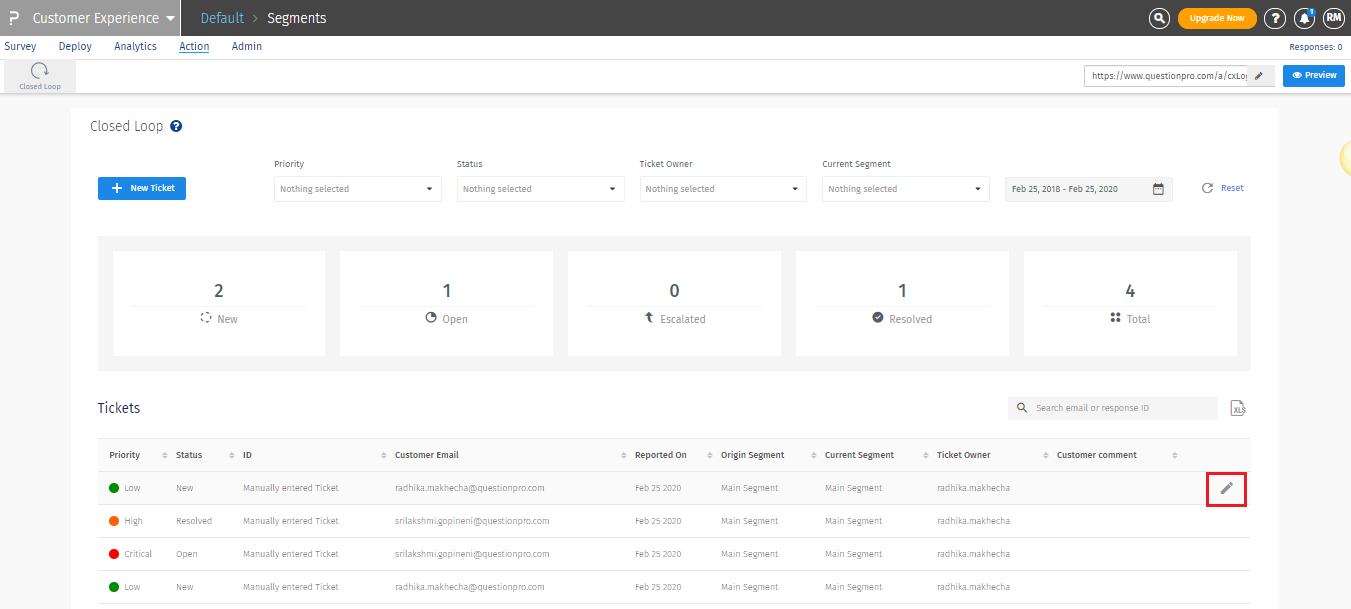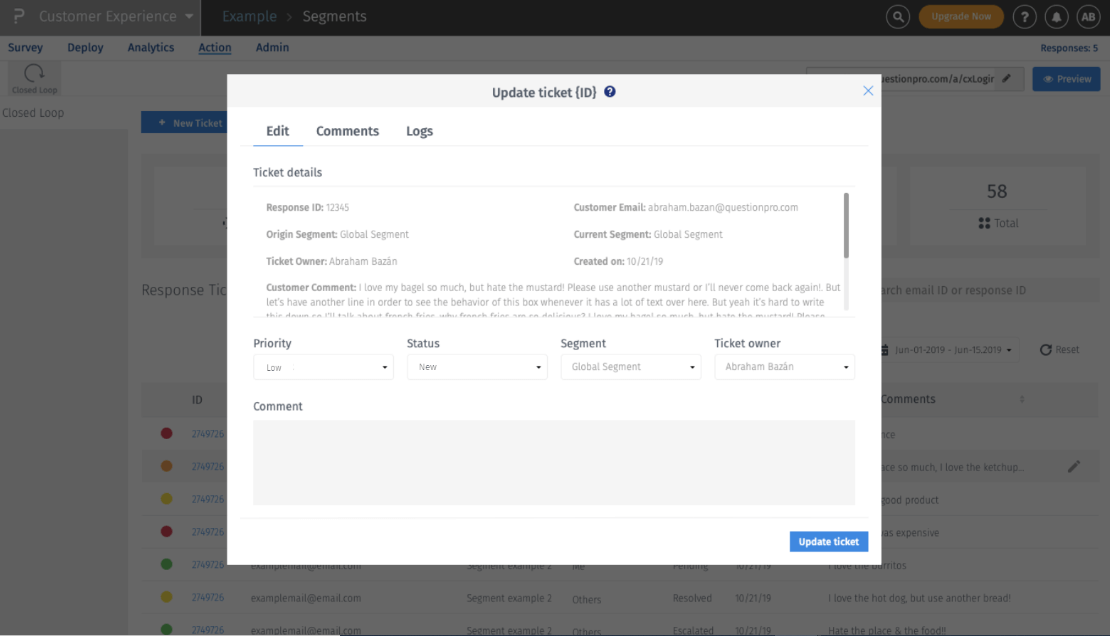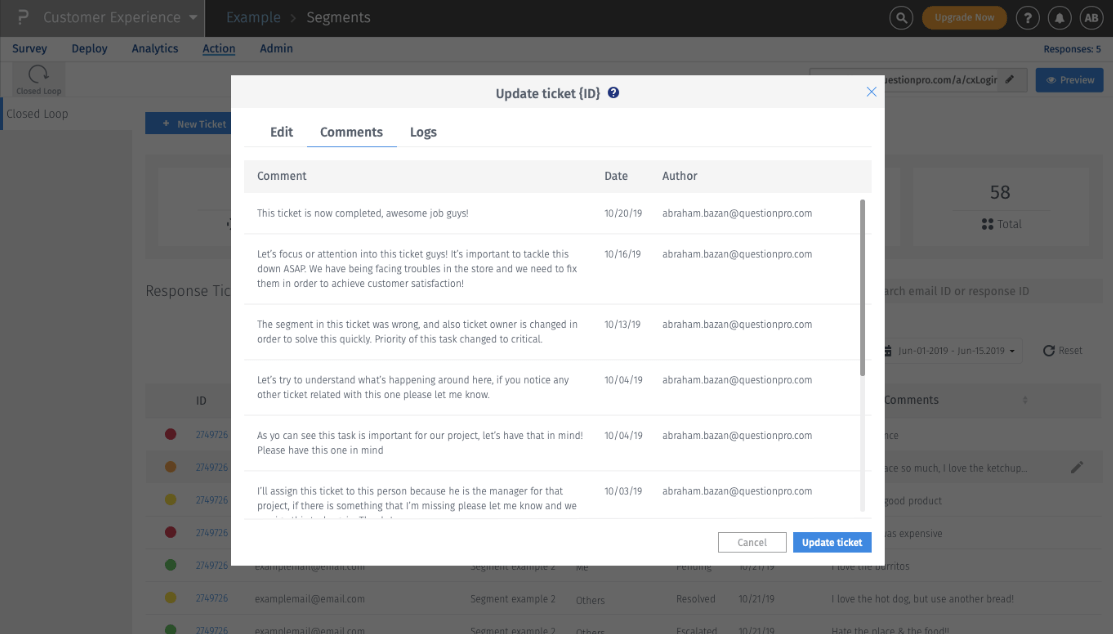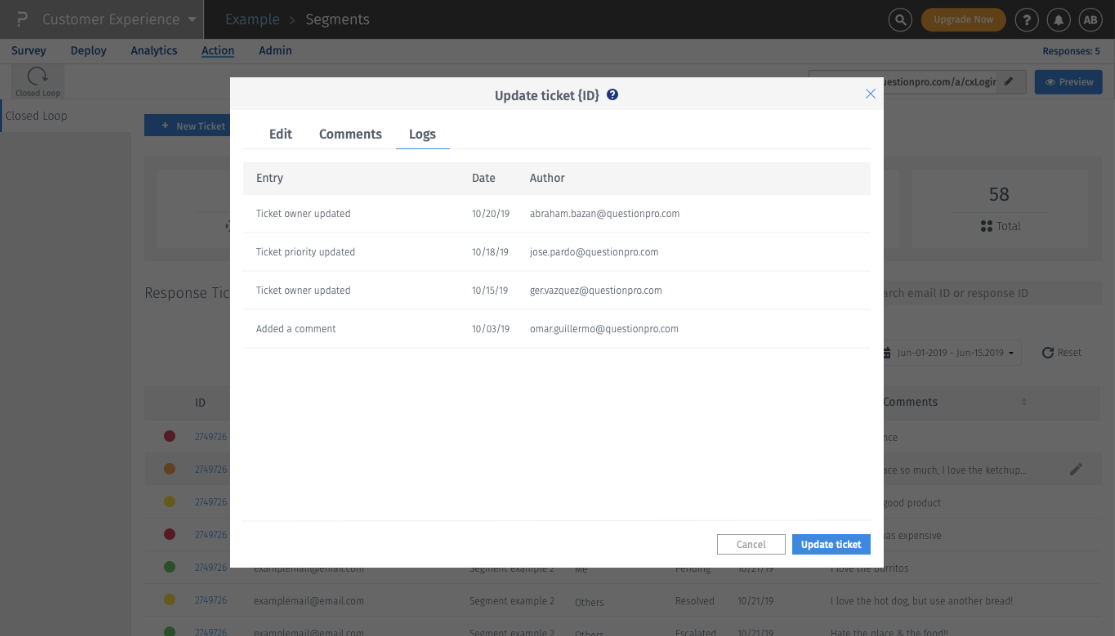CX closed loop
How often have you come across a grumbled customer pouring wrath on social media because of poor customer support experience or not-so-satisfying product experience?
It can cost your business very dear if not looked into on time. Of course, there are ways to control the damage, but by then it would have already ruined your online reputation.
There are better ways to tackle this. You can use customer experience software to get regular feedback and know what your customers like, or don’t like. As soon as you see a red (or yellow) flag, learn more about their experience and close the loop by taking action.
QuestionPro CX helps its users capture their customers’ journey at various touchpoints and gain real-time insights. Share their feedback with different teams to improve the overall customer experience. Understand their behavior and find out what factors drive it.
One of the most common ways to know what your customers think of your business is to conduct an NPS survey. It measures the probability of how likely they are to refer your business to their friends and family. Based on the NPS score, they are categorized into promoters, passives, and detractors.
With QuestionPro CX, you can close the feedback loop using a ticketing system. You can create a ticket for each detractor and assign it to the right person, and get the issue resolved. Such a mechanism can reduce the churn rate and eventually convert your detractors into promoters.
What’s new with closed-loop?
We have enhanced the closed-loop system to better manage tickets and address issues soon. Now the users will be able to
- Export tickets
- Reassign tickets
- Get an overview of tickets based on the status
- Get an automated email for any updates on tickets
- Filter based on priority, segment, owner
- Search ticket by email address or ticket ID

The closed-loop landing screen will show all tickets by default.
New ticket
While creating tickets, below fields are mandatory.
- Customer email
- Segment
- Comments
- Ticket owner
You can set the segment name and manager from the segments screen.
User can set the priority of the ticket as:
The status of the ticket can be:
- New – a new ticket with no action performed on it
- Open – a ticket which is being worked upon
- Resolved – a ticket which is taken care of
- Escalated – a ticket which needs to be taken care on a higher level
Once the ticket is created, email is sent out to the assigned person in “To” and CC all other managers.
Update ticket
To update the ticket, mouse over the ticket you want to edit. You will be able to see the update icon on the right side.

You can update below fields of the ticket.

You can assign it to the
- Sibling and child segments of the current segment, if the status is new/open/resolved.
- Immediate parent or above the current segment in the hierarchy, if the status is escalated.
Comments
While updating the ticket, you can see all the comments added for the ticket.

Logs
Under this tab, you can see all the log entries of the status changes.

With CX, create strategies to meet the ever-changing expectations of the customers. Keeping them happy can significantly improve your ROI. If you need help with how to improve customer experience, get in touch with us.
Five critical traits of closed-loop customer feedback mechanism
Let us look at the most critical traits of closed-loop customer feedback system.
- Identifying your customers: You have to know your customers before you follow-up on them. Following up on anonymous customers or understanding the reasons for their feedback is not going to work. Identifying your customers and learning about them will give you help you get better insights into their feedback and use these insights to avoid any future concerns. Brands have all sorts of customer data with them but are guilty of not using it to their advantage. Learn about them and reach out to them. This is a key first step in delivering excellent customer experience.
- Gathering data for action: When organizations conduct customer surveys, they are usually for measuring customer experience and customer satisfaction. When conducting closed-loop customer surveys, you need to change your questionnaire flow and questions a bit. The focus of these surveys is to get an understanding of what customers are thinking through open-end questions. This respondent information can then be shared with your various functions and departments to improve customer experience collectively.
- Automating your follow-ups: For your closed-loop program to succeed, it has to be automated to enable instantaneous follow-up. Systems that are not automated deliver all relevant information to the managers, but it is often too late to take any action. Customers appreciate immediate follow-up and action. Automating is an essential part of your closed-loop customer feedback mechanism’s success and managing unhappy or dissatisfied customers.
- Effectively managing cases: Managing and taking action on real-time customer feedback can be overwhelming for your managers or team members. This is where closed-loop case management comes in real handy. It can help managers delegate tasks, assign follow-up actions, and monitor progress on open cases. This not only helps monitor progress but ensures nothing gets missed, and all customer feedback points are addressed.
- Uncovering internal issues: Traditional customer surveys aim to measure customer satisfaction (CSAT) or customer experience (CX) after every customer interaction or annually. Surveys for closed-loop programs are customer-centric and aimed at significant and long-lasting improvements to your customer initiatives and operations. Since these are transformative in nature and approach, they help identify internal shortcomings and issues and fix them for long term gains. QuestionPro CX provides an enhanced closed-loop system to address customer issues effectively.
Benefits of closed-loop customer feedback
Closing the loop with your customers is always a great idea. Your customers trust you more, and it instills customer loyalty. Loyal customers are crucial for any business to succeed. They are promoters of your brand, give you repeat business, and wish for your success. Let us look at four key advantages of closed-loop customer feedback systems.
- Boost customer loyalty: In today’s day and age, customer loyalty has become very hard. There are several competing products and brands in the market. This has created massive challenges for brands to retain customers. Brand loyalty is low as compared to a few years ago. When brands close the feedback loop with their customers, they deliver a positive experience and a lasting impression. The customers feel valued, and it boosts customer loyalty. Richer, the experience, the more loyal your customers will be. Loyal customers save brands money, whereas acquiring new customers costs brands money.
- Boost staff performance: A closed-loop mechanism lets you optimize the performance of your employees. With closed-loop, employees get specific information that helps them learn, fix issues, and avoid them in the future. It helps in containing customer churn. Timely customer feedback management helps employees understand the problem, its urgency, and devise the best solution. Uncovering and understanding patterns help employees develop systems and solutions to address customer concerns, a key component to address recurring issues.
- Reduce negative word-of-mouth: PwC recently conducted a customer study showing that 32% of customers would stop purchasing from a brand after a single negative experience. That creates a significant impact on your customer churn numbers. Customers will talk about a negative experience more than a positive experience with their colleagues and loved ones. Positive customer experience is crucial for brand reputation and loyalty. This can be ensured by listening to customers and closing the loop promptly. It is alright if you cannot find a solution to their problems, acknowledging one and working towards addressing it is key to customer satisfaction. Your customers will appreciate that and will go a long in promoting loyalty and minimizing negative customer sentiment.
- Boost business revenue: Customer feedback helps in identifying gap areas and taking necessary steps to plug those gaps. Obtaining consistent customer feedback and using it to improve your customer processes and initiatives helps improve customer experience, elevate customer satisfaction, and improve customer retention. Loyal customers improve a brand’s business through repeat purchases and new customer recommendations.
Why is closed loop important?
Closed loop customer experience is when an organization directly reaches out to each customer feedback, who might not necessarily expect it. After successfully executing a customer experience program and gathering customer opinions and feedback, it is always advised that one must make improvements according to the received data. Closed loop customer feedback program allows organizations to follow-up with all the customers so that they can “close the loop” with each and every customer feedback.
Your unhappy customers are your greatest source of learning - Bill Gates.
Resolving the complaints provided by dissatisfied customers can help an organization to retain those customers and convert them into loyal buyers in the future. Closed loop feedback is a systematic cycle of making significant changes in the way an organization works according to customer feedback. It is an incredibly powerful tool to communicate to customers that their opinions are highly valued in a personal and customizable manner.
A promoter needs to be constantly kept satisfied, a passive needs to be worked on and converted into a promoter. The most difficult part is to forbid dissatisfied customers to convert into detractors and also make sure enough work is done on their feedback so that they can be eventually converted into promoters.
Closed-loop survey
Customers who fill out their opinions via surveys from an organization, expect some improvements as per their feedback sooner or later. Unhappy customers appreciate organizations which contact them to understand their concerns and eventually try and solve them.
Contacting customers to acknowledge them for their time and opinions will prompt these customers to stay loyal. If not, a customer will refrain from providing feedback the next time an organization conducts a survey. Maintaining an awesome customer experience by using Net Promoter Score question will help an organization to ‘close the loop’.
The ideal process of a closed loop customer experience is:
- A customer had a good/bad/ugly experience with an organization.
- This organization conducts an online survey to gain insights on this experience.
- A customer service team from this organization contacts this customer to better understand his/her feedback.
- This review is communicated to the stakeholders of this organization.
- This organization makes changes and enhancement according to the received customer feedback.
- These steps are repeated with each and every new customer experience.
 Survey software
Easy to use and accessible for everyone. Design, send and analyze online surveys.
Survey software
Easy to use and accessible for everyone. Design, send and analyze online surveys.
 Research Suite
A suite of enterprise-grade research tools for market research professionals.
Research Suite
A suite of enterprise-grade research tools for market research professionals.
 CX
Experiences change the world. Deliver the best with our CX management software.
CX
Experiences change the world. Deliver the best with our CX management software.
 Workforce
Create the best employee experience and act on real-time data from end to end.
Workforce
Create the best employee experience and act on real-time data from end to end.
